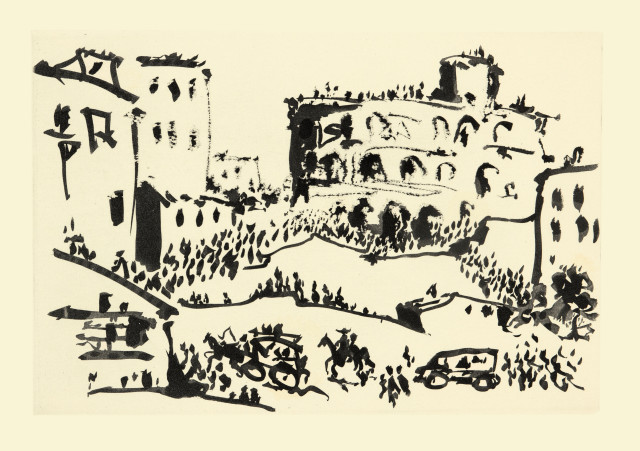- EN
Log in
- Live Auctions
- Past auctions
- More
- Gallery
- Art Dealing
- Publishing
- Kornfeld today
- The Story of Kornfeld
- Information













Málaga 1881 - 1973 Mougins
1959
In loose sheets, in illustrated orig. wrapper, in orig. parchment wrapper and slipcase. With 26 aquatint sheets and a drypoint on the cover
36x50.5 cm, parchment cover
Signed in pencil by the artist in the imprint and identified as number "97" of 220 copies of the standard edition
Goeppert/Cramer 100
Baer 970-996, each book edition
Bloch, Books, 95
Boston 244
On wove paper "Guarro", with a watermark designed by Picasso in the shape of a bull's head. Some leaves with single foxing spots, the endpaper and the title page with creases, only very few prints with small tears at the right margin. Cover and slipcase in good condition
"La Tauromaquia" is considered one of Picasso's most beautiful illustrated books. It is based on a text by the well-known bullfighter José Delgado (1754-1801), alias Pepe Illo or Pepe Hillo, who wrote a manual for bullfighters and "aficionados" in 1776. Goya already referred to this author in the etchings he created on this subject in 1816. Gustavo Gili senior commissioned Picasso's portfolio in 1927 with the aim of expanding his bibliophile collection "Ediciones de la cometa". Due to the wars in Spain and Europe, however, it was not realised until Gustavo Gili junior reminded Picasso of the book in 1956. So in the spring of 1957, in Cannes, a few days after the Easter bullfight he had attended in Arles, the artist began to paint various motifs with brushes on copper plates, which were then converted into aquatint. The 26 prints, mostly executed with a few brushstrokes, illustrate Picasso's skill as a draughtsman.
A masterpiece of European book art
1959
In losen Bogen und Blättern, in illustriertem Orig.-Umschlag, in Orig.-Pgt.-Umschlag und Schuber. Mit 26 Aquatintablättern und einer Kaltnadelarbeit auf dem Umschlag
36x50,5 cm, Pgt.-Umschlag
Im Impressum vom Künstler in Bleistift signiert und als Nummer "97" von 220 Exemplaren der Normalausgabe ausgewiesen
Goeppert/Cramer 100
Baer 970-996, jeweils Buchausgabe
Bloch, Bücher, 95
Boston 244
Auf Velin "Guarro", mit einem von Picasso entworfenen Wasserzeichen in Form eines Stierkopfes. Manche Blätter mit einzelnen Stockflecken, der Vorsatzbogen und das Titelblatt mit Knicken, nur ganz wenige Graphiken mit kleinen Einrissen am Rand rechts. Umschlag und Schuber in guter Erhaltung
"La Tauromaquia" gilt als eines der schönsten illustrierten Bücher von Picasso. Grundlage ist ein Text des bekannten Stierkämpfers José Delgado (1754-1801), alias Pepe Illo oder Pepe Hillo, der 1776 ein Handbuch für Stierkämpfer und "Aficionados" schrieb. Bereits Goya bezog sich in seinen Radierungen, die er 1816 zu dieser Thematik schuf, auf diesen Autor. Den Auftrag für Picassos Mappenwerk gab Gustavo Gili senior im Jahr 1927 mit dem Ziel, seine bibliophile Sammlung "Ediciones de la cometa" auszubauen. Durch die Kriege in Spanien und Europa wurde es jedoch nicht realisiert, bis Gustavo Gili junior Picasso 1956 an das Buch erinnerte. So begann der Künstler im Frühjahr 1957 in Cannes, einige Tage nach dem Oster-Stierkampf, den er in Arles besucht hatte, verschiedene Motive mit Pinsel auf Kupferplatten zu malen, die dann in Aquatinta umgesetzt wurden. Die 26 Graphiken, meist mit wenigen Pinselstrichen ausgeführt, verdeutlichen Picassos zeichnerisches Können
Ein Meisterwerk europäischer Buchkunst














